Husqvarna has been playing in the off-road shadows since its heyday in the late 1960s and early ’70s. But now with the might of BMW as parent company since 2007, the historic brand is making great strides in producing motorcycles that are competitive with its contemporary rivals. Spearheading the effort on these shores is Kris Odwarka, President of Husqvarna Motorcycles North America, a youthful and affable 49-year-old who was formerly the sales director at Alpina GmbH, a tuning company affiliated with BMW’s automotive group. Odwarka has worked for and around BMW for 20 years and was selected to head up Husky NA because of his extensive dirtbike background. He used to race Huskys in the late 1970s and is familiar with the brand’s perennial parts-supply issues and irregular new product.
“That issue of getting parts right, parts on time, when you order them at a decent price is the very first thing we did,” Odwarka told us. “Second is what you’re seeing now – get the models, especially on the dirtbike side, to be on time. We were able to fix half of that this year, and by model year 2013 I think you’ll see us fix the other half, and then we’ll be on cycle with everyone else.”
To demonstrate Husky’s progress, we were recently invited to test its 2012 lineup of bikes at The Ranch in Anza, California.
TE Dual-Sports - TE250, TE310, TE449 and TE511
European manufacturers like KTM and Husqvarna have been at the forefront of providing capable dirtbikes in street-legal packages, and Husky has four models in its dual-sport lineup. Compared to the enduro TXC line, the TEs add the requisite street equipment such as headlights, taillights and mirrors. Different fuel-injection tuning and the addition of catalytic converters and an evaporative canister complete the changes for the street.
The entire TE line receives many new updates, including a more rigid chromoly frame (now colored black) and silver (rather than black) Excel rims. New graphics add some aggressiveness to the package, and they’re now in a new in-mold plastic design (IPD) that will keep their good looks rather than peeling off like traditional decals.
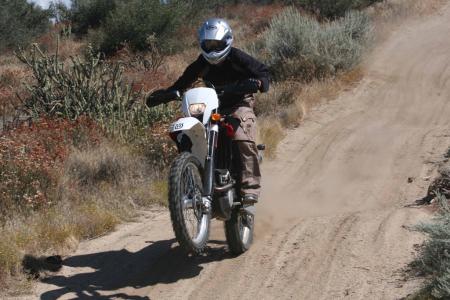 Newest of the Husky dual-sports is the TE250, now with shorter suspension and a 2-inch lower seat height to make it more palatable for commuter duties. Newest of the Husky dual-sports is the TE250, now with shorter suspension and a 2-inch lower seat height to make it more palatable for commuter duties. |
The headlining TE news for 2012 is a TE250 lowered nearly 2 inches to 35.8 inches, delivering a more manageable streetbike than the TE310’s 37.4-inch saddle while still maintaining its capability off-road. It’s an experiment solely for the North American market, helping the bike appeal to more riders and distinguishing it from the mechanically similar TE310.
The TE250 and 310 share basically the same single-cylinder powertrain with four titanium valves and a 6-speed transmission, the primary differences being the 310’s larger piston and extended stroke to yield 302cc instead of 250cc. Yes, despite the nomenclature, the TE310 actually displaces 302.44cc. Similarly, the TE511 has a 478cc displacement. The 250/310 boasts a new Leo Vince exhaust, which is claimed to boost performance and reduce weight by 300 grams. All-up weight is said to be 247 pounds with their 2.25-gallon tanks full.
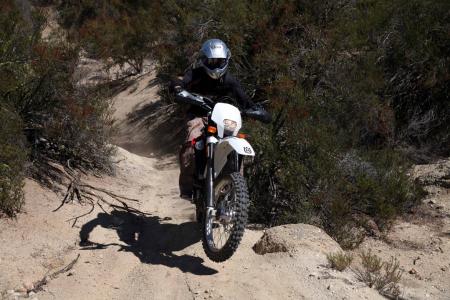 The TE250 is very nimble, and it does well off-road despite its shorter suspension. The TE250 is very nimble, and it does well off-road despite its shorter suspension. |
Response from the Mikuni fuel injection is mostly good, but it’s not as clean as the pure off-road TXC line which doesn’t have to meet the same emissions requirements as the street-legal TEs. The TEs would occasionally stall if the revs dropped too low, while the TXCs almost never lost their fire. Rekindling the flame is a reliable electric starter, augmented by a kick-start mechanism should the battery fail.
The TE250’s 2-inch lower seat really aids rider confidence in technical sections where a foot dab might be necessary, but there is less ground clearance to play with in ruts. The shorter suspension also deflects more over bumps that the 310 serenely cruises over. As always, there are compromises inherent in vehicle design. Ergonomic changes to enhance street or dirt use can be made by the two-position adjustable handlebars on the TE250/310.
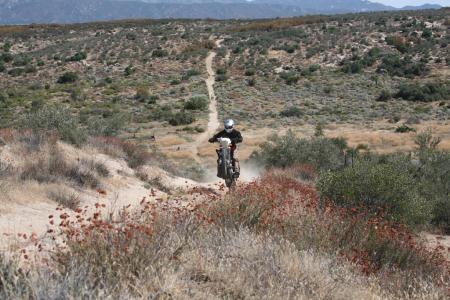 When the pavement ends, the TE250 keeps on truckin’. When the pavement ends, the TE250 keeps on truckin’. |
The TE250 retails for $7599, while the 310 costs $600 extra.
Like the similarities between the 250 and 310, the TE449 is nearly identical to the TE511, including their 249-pound curb weights. The only difference is the “511” enjoys a 3mm bigger bore to yield 478cc and a broadened powerband.
The TE449 ($8699) and 511 ($8999) also feature several updates for 2012, including a new one-piece tailsection and a simplified and more rugged wiring harness. A revised Kayaba shock lowers the seat height by 20mm to 37.7 inches. Both feel a little bulkier than the 250/310 on technical trails, but their larger engines have a surplus of power that better handles open desert riding and, presumably, street conditions. I say presumably because we didn’t get any road riding in, as we were on pre-production bikes that weren’t registered. We hope to get a TE or two for full testing in the near future.
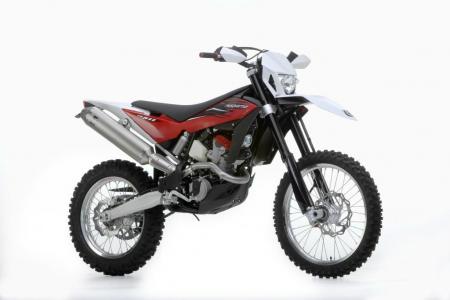 The TE511 is Husky’s biggest dual-sport, but don’t let its name mislead you. Its engine displaces an actual 478cc, not 510 of them. The TE511 is Husky’s biggest dual-sport, but don’t let its name mislead you. Its engine displaces an actual 478cc, not 510 of them. |
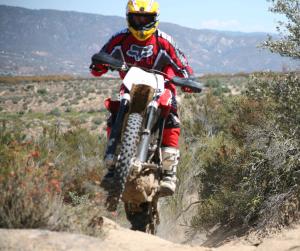 Husqvarna’s line of enduros mimics that of the TE dual-sport range, minus a 449cc version, with nearly identical mechanical specifications. A key distinction is the use of a 12-hole fuel injector and a different ECU and tuning from the TE’s 4-hole injector and EPA-compliant mapping. “It takes over where the TE has to leave off,” explained Corey Eastman, Husky’s Marketing Manager.
Husqvarna’s line of enduros mimics that of the TE dual-sport range, minus a 449cc version, with nearly identical mechanical specifications. A key distinction is the use of a 12-hole fuel injector and a different ECU and tuning from the TE’s 4-hole injector and EPA-compliant mapping. “It takes over where the TE has to leave off,” explained Corey Eastman, Husky’s Marketing Manager. Newest of the TXC bunch is the TXC310, an all-new model for 2012 retailing for $7889, $490 extra from the TXC250’s price. Due to their performance tuning, the 250/310 qualifies only for a California Red Sticker rather than the more open Green Sticker. Ridden back to back with the TXC250, the 302cc “310” does a better job at grunting up a gnarly uphill section due to its broader powerband, while the 250 requires a careful clutch hand to balance power with available traction. The 250 is slightly more agile at a crawling pace. To experience the TXC310 at higher speeds, I sampled the facility’s motocross track, a replica of the Carlsbad circuit circa the 1980s. It is refreshingly devoid of the massive jumps now commonplace on contemporary courses, so the enduro-aimed TXC had no trouble ripping it up at a quick pace. The TXC310 worked amazingly well, with plenty of grunt to plough through a sandy berm even if a gear high.
The entire TXC line receives a few updates for 2012, such as stiffer frames, new front and rear Kayaba suspension, IPD graphics and silver-anodized Excel rims. The TXC250 and TXC310 also feature new race-inspired Leo Vince exhaust systems. The TXC511 ($8299) is updated with new radiators and a re-tuned shock is lowered 4mm to improve the chassis geometry and provide more balance from front to rear. The TXC511 enjoys Green Sticker designation in California.
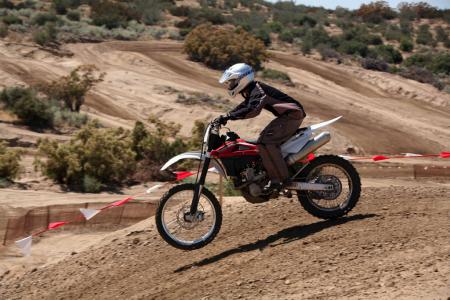 It was fun to toss around the TXC310 on the undulating layout of the Carlsbad-replica MX track at The Ranch in Anza, California. It was fun to toss around the TXC310 on the undulating layout of the Carlsbad-replica MX track at The Ranch in Anza, California. |
TC Motocross/GP Lineup – TC250, TC449, CR125
The TCs are Husky’s hardcore motocross machines, and the TC250 ($6999) four-stroker is the most heavily revised for 2012. BMW’s F1 experience has resulted in a new piston design that is lighter for quicker revving, plus a new cylinder head with DLC-coated finger followers in the valvetrain. Three different fuel maps are available for selection, and top-end power is increased via a new airbox and velocity stack. Vaunted exhaust supplier Akropovic provides the new exhaust system. The chromoly frame is more rigid, and new graphics are of the durable IPD variety.
The TC449 retails for $7999 and receives many of the 250’s updates. New valve timing and larger intake velocity stacks promise a broader powerband. A choice of two fuel/ignition maps are available via a switch on the handlebar.
A shortage of time and a deficiency in riding talent kept me off the four-stroke motocrossers, but I did manage to spin several laps on the two-stroke CR125 ($5999). Like the WR125, the CR receives a 144cc big-bore kit for extra poke down low. New to the bike are its stronger frame and IPD graphics.
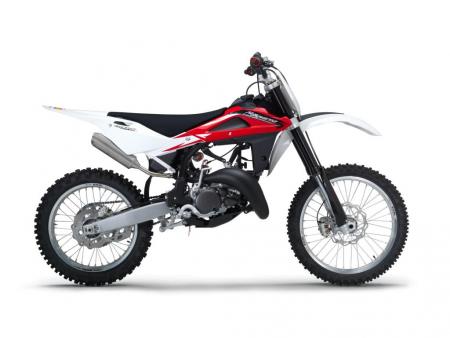 Husky’s CR125 two-stroke is incredibly light, weighing just 203 pounds. A 144cc big-bore kit is included at no extra charge. Husky’s CR125 two-stroke is incredibly light, weighing just 203 pounds. A 144cc big-bore kit is included at no extra charge. |



 22:51
22:51
 Unknown
Unknown


 Posted in:
Posted in: 







0 nhận xét:
Đăng nhận xét